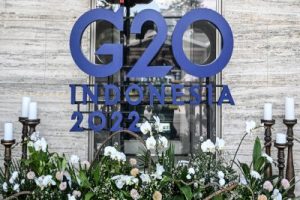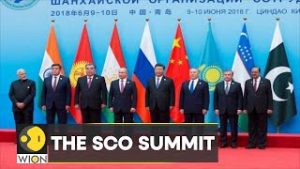
As we’ve already pointed out in a previous Substack Post from Alan’s Newsletter, focusing on Trump’s dramatic tariffs, reveals a growing global order confusion. Do we have a continuing ‘great power competition’ – the United States, Russia and China, key great powers butting heads whether in Ukraine, or Gaza or Taiwan and the South China Seas? Or, do we see with Trump 2.0 the emergence of a ‘great power collusion’? The ‘Big Boys’ establishing and maintaining ‘spheres of interest’. Or, just possibly are we enveloped currently in an international system where great power actions do little to constrain disorder. Indeed, their actions only add to the confusion and disorder in a highly conflict prone international system. The problem of course is that analysts are biased toward seeing some form of order where in fact it is just as likely none exists.
In this earlier Post on global order we quoted Stacie Goddard who has raised the contending competition versus collusion order dynamic:
“Now look it won’t stop analysts – both those determined to extract a logic and those likely not to, to keep examining the Trump policy action. Indeed I was attracted to the piece prepared by Stacie Goddard in Foreign Affairs (FA), “The Rise and Fall of Great-Power Competition: Trump’s New Spheres of Influence”. Now Goddard in the piece tackled the view that Trump’s strategic actions were driven by great power competition – a view adopted by many realist thinkers who see this as Trump’s logic focusing on US ‘interests’ in contrast to other administrations that have focused on ‘values’ and ‘collective global governance action’. As Goddard writes:
“But in the mid-2010s, a new consensus took hold. The era of cooperation was over, and U.S. strategy had to focus on Washington’s contests with its major rivals, China and Russia. The main priority of American foreign policy was clear: stay ahead of them.”
“Some hailed this consensus on great-power competition; others lamented it. But as Russia amped up its aggression in Ukraine, China made clear its designs on Taiwan, and the two autocratic powers deepened their ties and collaborated more closely with other U.S. rivals, few predicted that Washington would abandon competition as its guiding light. As Trump returned to the White House in 2025,many analysts expected continuity: a “Trump-Biden-Trump foreign policy,” as the title of an essay in Foreign Affairs described it.”
“Then came the first two months of Trump’s second term. With astonishing speed, Trump has shattered the consensus he helped create. Rather than compete with China and Russia, Trump now wants to work with them, seeking deals that, during his first term, would have seemed antithetical to U.S. interests.”
“These interpretations might have been persuasive in January. But it should now be clear that Trump’s vision of the world is not one of great-power competition but of great-power collusion: a “concert” system akin to the one that shaped Europe during the nineteenth century.”
“In Trump’s vision of a new concert, Russia and China must be treated as kindred spirits in quelling rampant disorder and worrisome social change. The United States will continue to compete with its peers, especially with China on issues of trade, but not at the expense of aiding the forces that Trump and his vice president, JD Vance, have called “enemies within”: illegal immigrants, Islamist terrorists, “woke” progressives, European-style socialists, and sexual minorities.”
But to determine the dynamic of the current international system, notwithstanding these classic global order structures just described by Goddard, there is the continuing, indeed possibly the rising mayhem in the international system. Switch for a moment to South Asia where we have just seen India’s ‘retaliation’ for an attack on Indian tourists in Kashmir. As reported in the NYTimes:
“India said early Wednesday that it had conducted several airstrikes on Pakistan, hailing a victory in the name of vengeance for the terrorist attack that killed 26 civilians in Kashmir last month.”
“The Indian government said its forces had struck nine sites in Pakistan and on Pakistan’s side of the disputed Kashmir region, in what it described as retaliation for a terrorist attack that killed 26 civilians in Kashmir.”
“But in recent years, particularly after both built deterrence through nuclear weapons in the 1990s, their military confrontations had been limited to largely along their border regions. While India in recent years has struck Pakistan-administered Kashmir and areas close to it during periods of rising tensions, the attack on Wednesday included strikes on Punjab, in mainland Pakistan, for the first time in more than half a century.” …
““The terrorist attack was one of the worst against Indian civilians in decades, and India was quick to suggest that Pakistan, its neighbor and archenemy, had been involved. The two countries have fought several wars over Kashmir, a region that they have split but that each claims in whole.””
The dilemma in this conflict between the two South Asian rivals is the absence of strong efforts to tamp down the conflict:
“Still, a major factor in the de-escalation of past India-Pakistan crises was international pressure brought to bear on both sides. And with Washington distracted and few other mutually trusted “honest brokers” available, that means it could be up to the two parties themselves to find an off-ramp.”
To say the least, that is troubling and seems to signal, not surprisingly, that a global order framing is at best a stretch in the current global environment. Nathan Gardels of the Berggruen Institute underlines the contingencies that haunt the current order in a recent Noema piece:
“In short, history is open in all directions. There is no through line you can draw that will tell us where it will all go and where it will end up. There are a multitude of possibilities and arrays of conditions everywhere, all at once, that will only have looked inevitable in retrospect.”
“Coherence and equilibrium are “the momentary exception” in the random swirl of disequilibrium that is the rule.”
“This understanding of the indeterminate direction of history not only departs from the modern paradigm of historical progression rooted in Judeo-Christian eschatology, or theology of destiny, but embraces its opposite in the “principle of reverse movement.” History can go forward, backward or sideways.”
Yup, forward, backward or even sideways. There might be order but in the face of a quixotic Trump administration and pugilistic Putin regime we may be stretching the notion of ‘order’ framing. Meanwhile, efforts by the EU and many member states to gather their collective will to take on their own defense – build policies that generate ‘sovereign autonomy’ with significantly less reliance on the US starting with Ukraine but building an independent European deterrence has become a subject. Richard Youngs, a senior fellow in the Democracy, Conflict, and Governance Program, based at Carnegie Europe has described this potential turning point. In a CEIP article he describes this ‘moment of truth:
“Writers, analysts, think tankers, journalists, and commentators seem to agree. A standard narrative has emerged that Europe faces a “moment of truth” and that “innovative formulas” are needed to advance European interests. Some insist that the crisis moment “has reignited a dormant sense of European purpose” or that “a different kind of Europe” is emerging in 2025. Others feel that Trump has already unleashed a new era of deeper European cooperation. A common view is that as the EU moves to “transform the way we protect ourselves, “this will “force a radical rethinking . . . of the nature of the EU.” In other words, deeper integration across the board will be needed to sustain Europe’s military buildup. The Economist believes that a “radical rethinking of how European nations confederate” may be emerging.”
Richard Samans, who is a Nonresident Senior Fellow – Global Economy and Development, Center for Sustainable Development at Brookings in a piece titled, “Rebalancing the world economy: Right idea but wrong approach”, suggests that Europe can/should act with the US and China to fix what he sees as an unbalanced global economy:
“The Trump administration’s norm-busting actions are a wake-up call that the contradictions and tensions in the system are unsustainable, extending well beyond trade rules. A Plaza/Louvre Accord or Bretton Woods-like moment appears to be approaching one way or the other, most likely during this or the next U.S. administration and quite possibly later this year.”
“Yes, Europe currently has its hands full developing a new defense strategy and helping to reach a responsible and durable resolution of the Russia-Ukraine war. But its defense-related fiscal spending plans give it a strategic, first-mover advantage in an international macroeconomic coordination negotiation aimed at reducing economic imbalances. In particular, Germany’s long overdue relaxation of its debt brake has given Europe crucial new table stakes, reversing decades of history in which Germany’s fiscal posture prevented Europe from playing a leadership role in such settings.”
Europe seems to be a key actor, and more critically, Germany’s stepping up to a key organizing role in Europe is vital. Yet that is exactly what appears to be the problem. Yes, changing the debt brake and encouraging the new German coalition of CDU/CSU -SPD to take a more dramatic European leaders’ role is front and centre in Europe but the emergence of Friedrich Merz as the coalition’s new Chancellor posted an uninvited warning sign. As described in WPR:
“Instead, it became a nailbiter, in large part because the investiture vote is a secret ballot, allowing members of Merz’ coalition to vote against him or abstain in protest. And indeed, they did, with Merz falling six votes short of the 316 needed in the first vote despite his CDU-SPD coalition holding 328 seats. And in the second round, he still only reached 325 votes. Of course, because of the nature of the ballot, it remains unclear if the dissension to his leadership is coming from his own CDU—which is known to have rival factions—or from members of the SPD.”
“Regardless, it suggests that Merz’s coalition, already one of the slimmest majorities seen in postwar Germany, is even more fragile than previously assumed. That gives him less room to maneuver in implementing his party’s agenda, and considering that Merz had already shown signs of abrasiveness as a leader, the dissension bodes poorly for future votes. It also hands the far-right Alternative for Germany, or AfD, even more ammunition to throw at his leadership and the country’s mainstream parties.”
“More broadly, the turmoil today came after months in which Merz had signaled he was prepared to return Germany to its historically strong leadership position in Europe, even scheduling trips to Paris and Warsaw for tomorrow before even securing the chancellorship. At a time of heightened global uncertainty and a power vacuum in EU affairs, Merz’s proactive and muscular moves to reestablish German influence even prior to taking office had been more than welcomed in Brussels and other European capitals. The events of today, though, suggest that those expectations may have been too high and the enthusiasm premature—not the first time that has been the case for Berlin in recent years”
Still Merz seemed to have gathered himself and set off for meetings with European colleagues. As described by by Roger Cohen in the NYTimes:
“Taking office as Germany’s new chancellor, Friedrich Merz headed straight for Paris on Wednesday to meet with Mr. Macron. The two leaders are united in seeking what Mr. Merz has called “independence” and what Mr. Macron calls “strategic autonomy” from Washington, a dramatic shift. Writing in the French daily Le Figaro, they said they “will never accept an imposed peace and will continue to support Ukraine against Russian aggression.””
Still the path forward for Europe and others is not clear. Roger Cohen makes that clear:
“But Europe is scarcely united, whatever the resolve in Paris and Berlin. The nationalist, anti-immigrant, anti-climate-science, anti-transgender wave that swept Mr. Trump into office last year is also potent across a continent where it has empowered Viktor Orban in Hungary and Giorgia Meloni in Italy, among others.”
With Trump 2.0 in play the global order dynamics are confused and incomplete. Europe still needs to show its unity and purpose if strategic autonomy is to become a thing. For now, the global order dynamic may just be wishful thinking.
Image Credit” DW News
This Post first appeared at my Substack as a Post there –
Is there Order? The Growing Confusion – https://globalsummitryproject.substack.com/p/is-there-order-the-growing-confusion

 We are definitely in the midst of Global Summitry gatherings. With the BRICS Summit just recently ended, we are deep into the G20 weekend gathering in New Delhi. So much commentary has accompanied these summitry gatherings. But I caution casual observers and readers: there are way too many assessments and conclusions drawn by all those folks that unfortunately barely pay attention to Global Summitry through much of the year. You can see this in the various ‘hair on fire’ commentaries in the assessments and consequences of the actions of key players in both the BRICS and now especially with the G20. Too many declarations of the G20 demise; firm conclusions that China and Russia would block any consensus statement that sought to condemn Russia’s aggression against Ukraine; the fragmentation of global summitry with the rise of the BRICS plus and the demise of the G20 with leaders from Russia and China choosing to absent themselves from summit.
We are definitely in the midst of Global Summitry gatherings. With the BRICS Summit just recently ended, we are deep into the G20 weekend gathering in New Delhi. So much commentary has accompanied these summitry gatherings. But I caution casual observers and readers: there are way too many assessments and conclusions drawn by all those folks that unfortunately barely pay attention to Global Summitry through much of the year. You can see this in the various ‘hair on fire’ commentaries in the assessments and consequences of the actions of key players in both the BRICS and now especially with the G20. Too many declarations of the G20 demise; firm conclusions that China and Russia would block any consensus statement that sought to condemn Russia’s aggression against Ukraine; the fragmentation of global summitry with the rise of the BRICS plus and the demise of the G20 with leaders from Russia and China choosing to absent themselves from summit. The CWD focused recent attention on the global management of debt and the growing threat of a sovereign debt crisis. After a number of virtual gatherings and much focused discussion, the CWD completed a Debt Management Proposal that CWD passed to folks in India as India scheduled the first G20 Finance Ministers and Central Bankers Ministerial at Bangalore, or its official name, Bengaluru.
The CWD focused recent attention on the global management of debt and the growing threat of a sovereign debt crisis. After a number of virtual gatherings and much focused discussion, the CWD completed a Debt Management Proposal that CWD passed to folks in India as India scheduled the first G20 Finance Ministers and Central Bankers Ministerial at Bangalore, or its official name, Bengaluru. 

